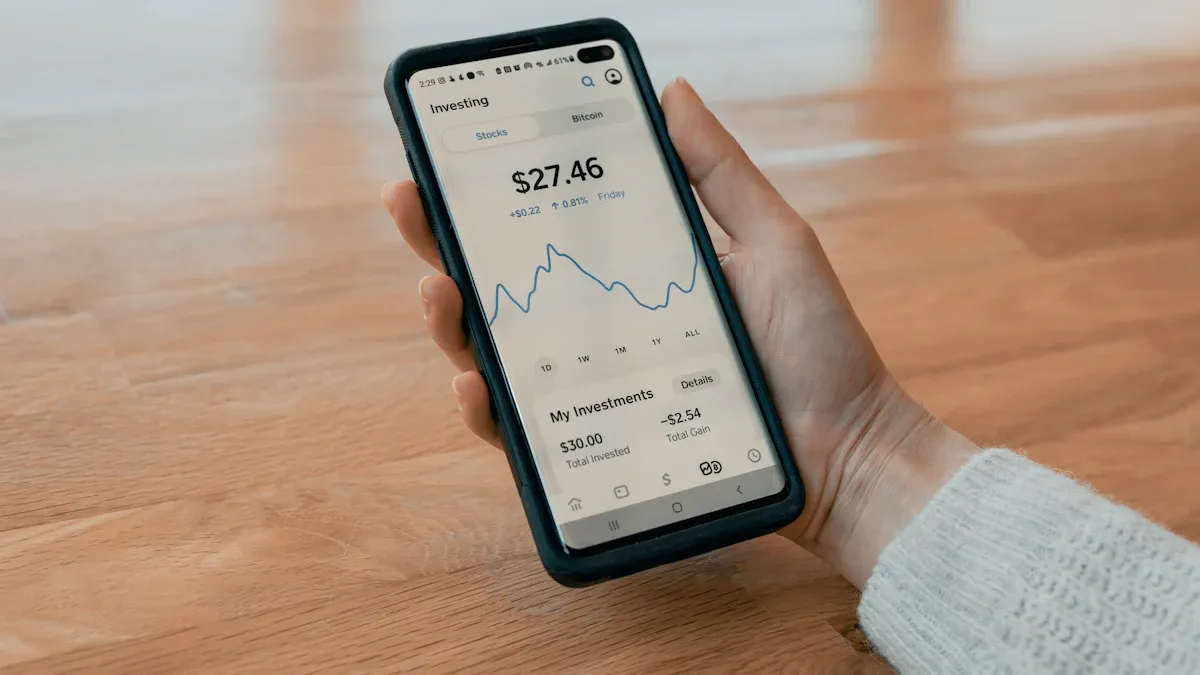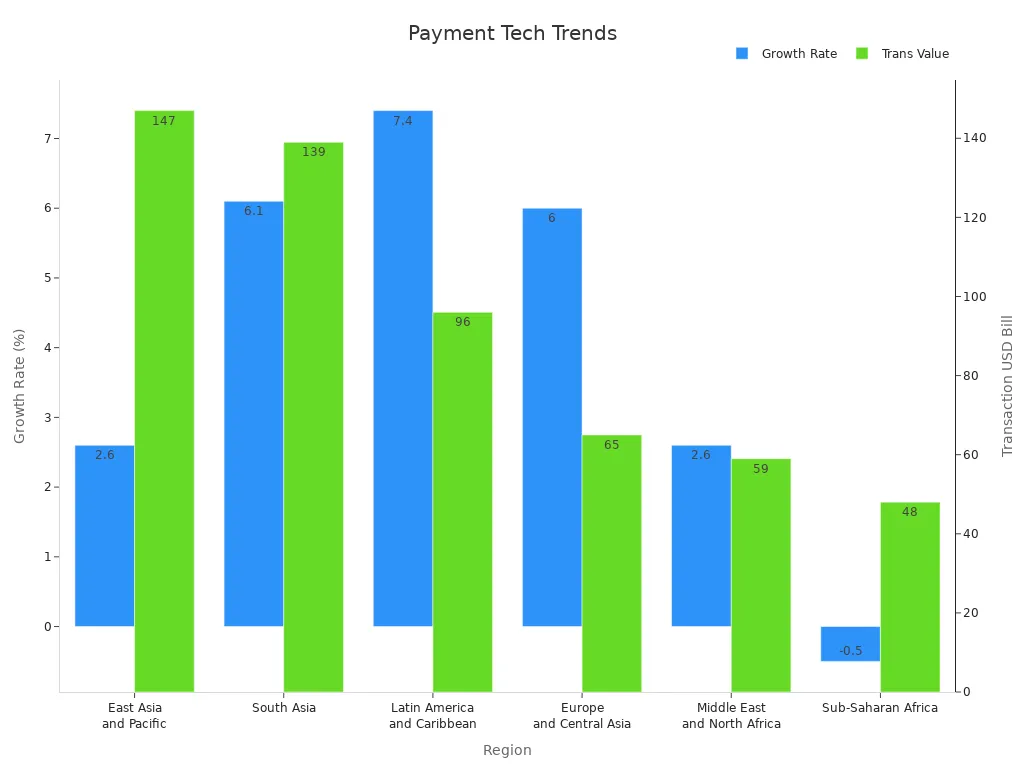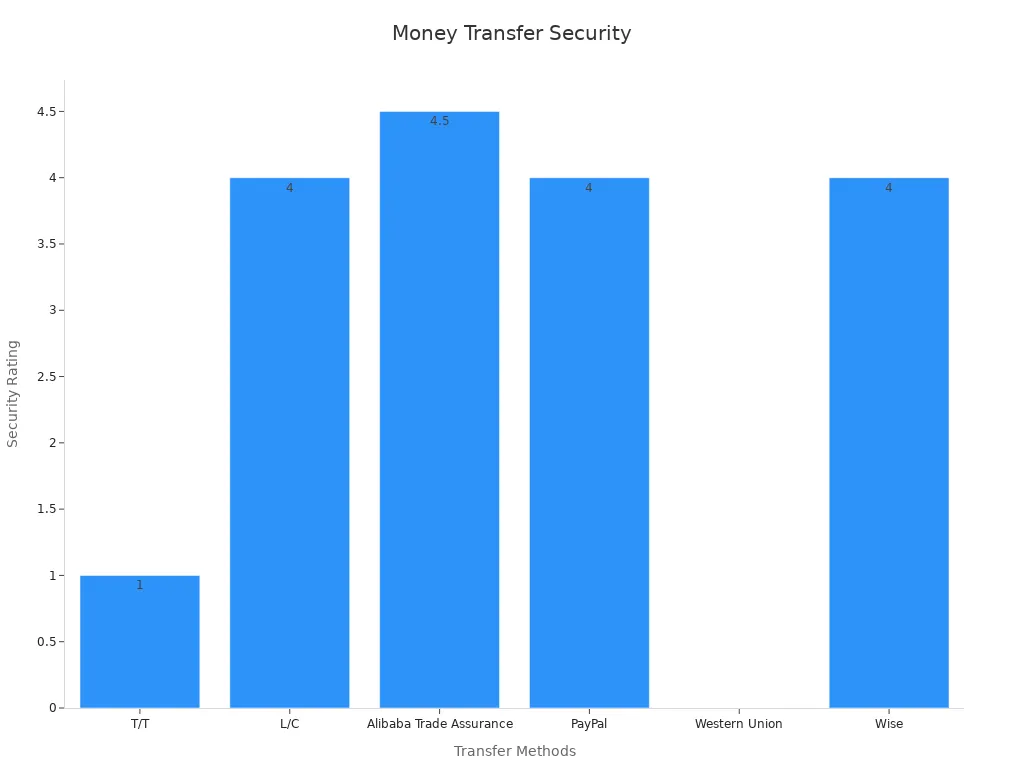
In 2025, knowing how to send money to China is very important. China’s digital payments are expected to reach $5.20 trillion by 2027. Businesses need to handle this growing system carefully. Picking the right way to pay can save up to 30% in fees. Using tools like CIPS for yuan payments helps save money. Fintech platforms now give real-time rates and faster transfers. This makes sending money across borders easier and cheaper.
Saving money isn’t the only thing that matters. Following rules is very important too. Payments over $50,000 USD need extra checks by SAFE. Breaking KYC or AML rules can cause fines. By learning the rules, you can avoid delays, save money, and keep your payments safe when sending money to China.
Key Takeaways
Picking the right way to send money saves up to 30%.
Knowing Chinese bank rules is important. Names must match to avoid problems.
Apps like Wise and Payoneer send money faster and cheaper.
Watch out for hidden costs. Compare prices to get the best deal.
Keep papers neat and correct for easy and legal payments.
Send money at the right time to get better exchange rates.
Trusting suppliers can lead to easier payments and better deals.
Use services like Yansourcing for help with payments and shipping to China.
Understanding the Chinese Banking System and Regulatory Environment
Overview of the Chinese Banking System
Sending money to China is different from other places. It’s not just about sending money; you must follow rules. For example, you can only transfer money between accounts with the same name. This means you can’t send money from a business account to a personal one.
Companies also need to register with the Cross-Border RMB Payment and Receipt Management Information System (RCPMIS). This system tracks all payments to make sure they follow the rules. You’ll also need to share details like the recipient bank’s address and why you’re sending the money. These steps may seem like a lot, but they help avoid problems.
If you want faster and cheaper transfers, platforms like Airwallex are helpful. They offer good exchange rates and low fees. Most payments are done in 3 to 5 business days, sometimes even on the same day. There are no surprise fees, so you can focus on your work.
Key Regulatory Bodies Governing Remittance to China
China has strict rules to protect its financial system. The State Administration of Foreign Exchange (SAFE) is very important. It checks foreign currency transactions and makes sure rules are followed. If you send more than $50,000, SAFE will do extra checks.
The People’s Bank of China (PBOC) is another important group. It manages money policies and ensures payments match the country’s financial goals. The PBOC also works with banks to watch cross-border payments.
Other groups, like the China Banking and Insurance Regulatory Commission (CBIRC), focus on keeping banks stable. They make sure banks follow the rules for international payments. Knowing about these groups can help you understand the system better.
Challenges in Navigating Chinese Regulations for Sending Payments
Following China’s payment rules can feel hard. First, there’s a lot of paperwork. Chinese suppliers getting USD payments must finish approval in five days. They also need to match sales with payments, which is harder with different currencies.
Capital controls make things more complicated. Since 2016, people can only change $50,000 into other currencies each year. During busy times, banks check documents more closely. This can cause delays.
Foreign Invested Enterprises (FIEs) have their own problems. They must give many documents for payment approvals, and there’s no set time for reviews. This can slow down cash flow and hurt business plans. Changing exchange rates and big payments for many customers make it harder.
Even with these problems, learning the system can help. Being ready and informed can save time and money. It also helps make sure your payments to China go smoothly.
Main Methods to Send Money to China
Bank Transfers for Sending Payments to China
How Bank Transfers Work
Bank transfers, also called wire transfers, are a common way to send money to China. You start the transfer through your bank by giving details like the recipient’s account number, bank name, and SWIFT code. For businesses, this method works well for paying Chinese suppliers. But, the recipient’s bank account name must match the invoice to follow Chinese rules.
Fees and Processing Times
Bank transfers usually have low fees, but costs depend on your bank and the amount sent. Transfers take 3 to 5 business days. Some international transfers may take longer because of extra checks.
Transfer Fees | Exchange Rates | |
|---|---|---|
Bank Transfers | Low fees | Competitive |
Remitly | Fees vary by limit | Good |
PayPal | Currency fees apply | Good |
Pros and Cons of Bank Transfers
Pros:
Safe and trusted for big payments.
Good exchange rates for sending money abroad.
Cons:
Slower than other payment methods.
Needs detailed paperwork, which takes time.
Online Money Transfer Platforms for Businesses
Popular Platforms and Their Features
Services like Wise, Remitly, and Payoneer make sending money easier. These platforms are simple to use, offer live tracking, and have fair exchange rates. For businesses, they make managing payments faster and more convenient.
Online transfer platforms are growing fast in China’s business market.
In 2022, MTOs handled 39.8% of digital remittances, showing trust.
Costs and Exchange Rates
These platforms often cost less than banks for sending money to China. Exchange rates are clear, so you know how much the recipient gets. Fees depend on the amount and how quickly you want the transfer.
Advantages and Limitations
Advantages:
Quicker than bank transfers, with some done in minutes.
Clear pricing with no hidden charges.
Limitations:
Not great for very large payments due to limits.
Some platforms don’t support all currencies.
Alternative Methods for Sending Payments
Cryptocurrency Transfers
Cryptocurrency is a way to send money without banks. Bitcoin and Ethereum are popular options. But China’s strict crypto rules make this hard for businesses. It’s cheap and private but lacks buyer protection.
Payment Service Providers (e.g., PayPal, Alipay)
E-wallets like PayPal and Alipay are fast and easy for sending money to China. Alipay is widely used in China, making it a top choice for businesses.
Trade Finance and Letters of Credit
For big payments, trade finance tools like letters of credit are best. They protect both the buyer and seller. Though they need more paperwork, they are very reliable for global payments.
Tip: Using different payment methods can save money and follow rules when sending money to China.
Comparing Costs and Financial Considerations
Exchange Rates and Their Impact on Sending Payments to China
Exchange rates affect how much money your recipient gets. Even small rate changes can make a big difference. For example, if the yuan becomes stronger than the dollar, you’ll need more dollars to send the same amount in yuan. This can raise your costs a lot.
Timing is important when sending money. Exchange rates change all day, so picking the right time can save money. Platforms like Wise and Payoneer show live rates. This helps you get the best deal. Banks often use worse rates, which can cost you more.
If your business sends money often, use tools like rate alerts or fixed rates. These features help you plan better and avoid surprises from sudden rate changes.
Hidden Fees to Watch Out For
Hidden fees can increase your costs when sending money to China. Banks often charge extra for international transfers. These include fees for middle banks, currency changes, and paperwork. The upfront fee may look small, but the total cost can be much higher.
Online platforms like Alipay and PayPal are clearer about their fees. They show the exact cost before you confirm the transfer. But some platforms may still charge extra for faster transfers or certain currencies.
To avoid surprises, always read the details carefully. Look for terms like “service fees” or “processing charges.” Comparing different services can help you find the cheapest option for your business.
Tip: Pick platforms with clear pricing. Avoid those with unclear fees. Transparency helps you save money when sending money to China.
Cost Comparison of Different Remittance Methods
The best way to send money depends on what you need—speed, cost, or reliability. Here’s a simple comparison of average costs for different methods:
Remittance Method | Average Cost (%) |
|---|---|
Mobile Operators | |
Money Transfer Operators | 5.5 |
Post Offices | 7.7 |
Banks | 12.0 |
Digital methods, like e-wallets, are usually cheaper than non-digital ones. Digital transfers cost about 5%, while non-digital ones cost around 7%.
For businesses, reliability matters as much as cost. Services like Wise and Payoneer have good rates and fast transfers. These are great for cross-border payments. Banks are reliable but slower and more expensive.
Provider | Transfer Fee | Speed | Reliability |
|---|---|---|---|
$X | Y days | High | |
Provider B | $Y | Z days | Medium |
Provider C | $Z | W days | Low |
By comparing options, you can choose what works best for you. Whether you want low fees or fast transfers, knowing the costs ahead helps you decide wisely.
Legal and Regulatory Requirements for Sending Payments to China
Following Chinese Rules for Cross-Border Payments
When sending money to China, you must follow strict rules. These rules keep payments safe and match China’s financial goals. One important system is the Cross-Border Interbank Payments System (CIPS). It is managed by the People’s Bank of China (PBOC) and helps with international money transfers. Right now, only 2% of cross-border payments use the renminbi, but this could grow in the future.
To follow Chinese laws, businesses and banks must obey capital controls. These rules are like anti-money-laundering (AML) laws in other countries. For example, if you pay Chinese suppliers, your paperwork must match the invoice. If you don’t follow the rules, your payment could be delayed or fined.
Aspect | Details |
|---|---|
Legal Framework | CIPS follows capital controls and is managed by the PBOC. |
Compliance | Banks must follow strict rules, like AML laws. |
Internationalization | CIPS supports the renminbi as a global currency. |
Participants | Includes 76 direct and 1,304 indirect members worldwide. |
Transaction Growth | CIPS transactions grew 75% in 2021. |
Global Rules That Impact Payments to China
International rules also affect sending money to China. For example, China updated tax rules for sending over $50,000. You must file a tax record with the state tax office. This step tells the government about your payment but doesn’t involve a full tax review. These updates make it easier for businesses to send money in and out of China.
Foreign payment companies have extra rules to follow. They need special licenses and must handle data correctly. New rules, like the Draft Administrative Measure for Cross-Border Payment Service, aim to help foreign companies join China’s payment market.
Regulation | Description |
|---|---|
Administrative Measures for the Payment Services Provided by Non-financial Institutions | Sets rules for foreign payment companies in China. |
Announcement on Matters concerning Foreign-Funded Payment Institutions | Requires licenses and proper data handling. |
Draft Administrative Measure for Cross-Border Payment Service | Opens new chances for foreign companies in payments. |
Paperwork and Reporting for Businesses
Having the right paperwork is very important when sending money to China. You need to provide invoices, contracts, and proof of why you’re sending the money. Payments over $50,000 need extra checks by the State Administration of Foreign Exchange (SAFE). These checks make sure your payment follows Chinese and global rules.
E-wallets like Alipay and PayPal make some steps easier by giving clear instructions. But bank transfers often need more paperwork. To avoid problems, make sure all documents match the recipient’s details and payment purpose. This is especially important when paying Chinese suppliers. Wrong information can cause your payment to be rejected.
Tip: Keep your documents neat and updated. This will save time and help you avoid problems when sending money to China.
Best Practices for Businesses Sending Payments to China
Timing Payments for Optimal Exchange Rates
Choosing the right time to send money saves money. Exchange rates change all day, even small changes matter. Watching the market helps you send money when rates are better. Tools with AI can predict rate changes and help you save.
For example, using tools to manage currency changes lowers risks. These tools check market trends and tell you when rates are good. This way, you can plan payments wisely and spend less on sending money.
Tip: Use rate alerts from your payment service. This helps you catch good rates.
Evidence Type | Description |
|---|---|
AI tools track exchange rates and predict changes. | |
Business Benefit | Businesses can save money by sending payments at better rates. |
Negotiating Payment Terms with Chinese Suppliers
Good relationships with suppliers help you get better deals. Trust is very important. Suppliers give flexible terms if they trust you. Keep your paperwork clear and organized to avoid confusion.
You can also use forward contracts to lock in exchange rates. This protects you from sudden cost increases. Another idea is to suggest a 30:40:30 payment plan. This splits payments fairly and ensures quality work from suppliers.
Pro Tip: Always pay into official business accounts. This keeps payments safe and easy to track.
Keep documents clear to avoid confusion and show agreements.
Use forward contracts to protect against currency risks.
Build trust with suppliers for better cooperation.
Try a 30:40:30 payment plan to share risks fairly.
Record all payments to solve problems quickly.
Ensuring Secure Transactions and Avoiding Scams
Safety is very important when sending money to China. Scams can happen, so always check the recipient’s details. Confirm account numbers, business names, and the reason for payment.
E-wallets like Alipay and PayPal are safer for small payments. They offer buyer protection and clear instructions. For big payments, bank transfers are more secure. They need more paperwork but protect you better from fraud.
China’s new rules also make payments safer. Free Trade Zones (FTZs) share lists of data that don’t need extra checks. This makes sending money easier and still follows the law.
Key Update | Description |
|---|---|
Some data, like employee info, doesn’t need extra checks. | |
Increased Security Assessment Threshold | Data for 100,000 to 1 million people can skip security reviews. |
Negative Lists in FTZs | FTZs list data that doesn’t need extra checks, making transfers easier. |
Reminder: Use trusted services and follow rules to stay safe and avoid scams.
Using Yansourcing for Easy Payments and Shipping
Sending money and goods to China can be hard. Yansourcing helps make it simple. With over 10 years of experience, they offer solutions that fit your needs. Whether your business is new or big, Yansourcing handles payments and shipping safely and quickly.
Why Pick Yansourcing for Payments?
Yansourcing knows cross-border payments can be tricky. They help you follow Chinese rules like SAFE checks and CIPS steps. This avoids fines and delays. Their team makes sure your payments meet all legal rules.
Here’s how Yansourcing helps with payments:
Compliance Help: They take care of SAFE and other paperwork.
Saving Money: Yansourcing finds the best ways to lower fees.
Clear Costs: You’ll see where your money goes, with no surprises.
Pro Tip: Yansourcing can tell you the best times to send money to save more.
Making Shipping Simple with Yansourcing
Shipping from China can be confusing. Customs, storage, and delivery can cause stress. Yansourcing handles these tasks, so you can focus on your business. They offer air, sea, and rail shipping options to fit your needs.
Main Features of Yansourcing’s Shipping Services:
Live Tracking: Always know where your shipment is.
Customs Help: Avoid delays with their expert customs service.
Flexible Shipping: Choose door-to-door, port-to-port, or airport-to-airport delivery.
Service | Benefit |
|---|---|
Live Tracking | Gives peace of mind and clear updates. |
Customs Help | Prevents delays and follows global rules. |
Flexible Shipping | Offers choices for different business needs. |
Why Yansourcing Stands Out
Yansourcing does more than payments and shipping. They are your partner, making every step easy. Their focus on helping customers means you’ll always get support. Plus, their skills in sourcing and quality checks add extra value to your business.
Reminder: Working with Yansourcing means less stress and more time to grow your business.
By using Yansourcing’s payment and shipping services, you save time, cut costs, and follow rules. Want to make things easier? Yansourcing is ready to help.
Trends and Opportunities in Cross-Border Payments to China

How Fintech is Changing Money Transfers
Fintech is changing how businesses send money. As the world becomes more connected, fast and safe payments are more important. Fintech companies now offer tools to make sending money easier and cheaper.
Platforms like Wise and Payoneer show live exchange rates and clear fees. These features help businesses manage money better when paying in China. Blockchain is also becoming popular. It speeds up payments and makes them more secure, which builds trust.
The global money transfer market is growing fast, especially in Asia-Pacific. Here’s a quick look at its growth:
Global trade needs better payment systems.
Digital payments are becoming normal thanks to fintech advances.
Year | Market Value (USD) | CAGR (%) |
|---|---|---|
2023 | 30 Billion | N/A |
2031 | 80 Billion | 15.5 |
Fintech isn’t just a trend. It’s a must for businesses to stay competitive in cross-border payments.
New Payment Technologies in 2025
In 2025, new payment tools will change the game. Blockchain and real-time banking are making money transfers faster and cheaper. These tools also improve security and transparency.
For example, Ripple uses blockchain to make payments easier. Real-time banking lets businesses pay in minutes, not days. This is helpful for companies working with Chinese suppliers, where quick payments build trust.
Digital payments are also growing fast. In France and Poland, over 60% of people use digital tools for international payments. Even in the U.S., digital payments are becoming more common. The COVID-19 pandemic sped up this change, with 65% of people in developing countries using digital payments more.
Here’s a look at regional growth in money transfers:
Region | Growth Rate (%) | Transaction Value (USD Billion) |
|---|---|---|
East Asia and Pacific | 2.6 | 147 |
South Asia | 6.1 | 139 |
Latin America and Caribbean | 7.4 | 96 |
Europe and Central Asia | 6 | 65 |
Middle East and North Africa | 2.6 | 59 |
Sub-Saharan Africa | -0.5 | 48 |

These changes show why businesses need to keep up with new payment tools to stay competitive.
Tips for Businesses Adapting to Payment Changes
Businesses must adjust to new payment trends to succeed in China. Mobile payment apps like Alipay and WeChat Pay are now essential. They make payments easy and build trust with customers.
To do well, you need a good plan for entering the market. China’s market is big and complex, so knowing customer habits and competitors is key. Looking at smaller cities can also help. These areas often have less competition and more chances to grow.
Here are some tips to help you adapt:
Use mobile payment apps to make payments easier for customers.
Create a market plan that fits China’s unique needs.
Check out smaller cities for new opportunities.
Learn about new tools like blockchain and real-time banking.
By following these tips, you can handle cross-border payments better and grow your business in China.
Conclusion
Sending money to China can be simple if you pick the right way and stay informed. Whether you use T/T for big orders or platforms like Wise to save money, each option has its own benefits. Here’s a quick guide to help you choose:
Method | Security (1-5) | Cost | Speed | Best For |
|---|---|---|---|---|
T/T | 1 | $25-$50 | 3-5 days | Big orders with trusted suppliers |
L/C | 4 | Varies (bank fees) | Varies | Safe, high-value transactions |
Alibaba Trade Assurance | 4.5 | 2.95% | Instant | Buying on Alibaba |
PayPal | 4 | 3.4%-4.4% + $35 | Instant | Small or test orders |
Wise | 4 | 0.5%-1% | 1-2 days | Buyers wanting lower costs |

Keeping up with rules is also very important. New tools now give detailed data and track each transaction. This reduces mistakes and helps follow the rules better. These tools save time and help you make smarter choices.
Yansourcing makes things even easier by offering custom payment and shipping solutions. They know Chinese rules well and help cut costs. If you want an easy way to send money to China, Yansourcing is a great choice.
Tip: Use technology and expert services like Yansourcing to save time, cut costs, and keep your payments safe.
FAQ
1. What is the fastest way to send money to China?
Using online platforms like Wise or Payoneer is the quickest option. They often complete payments in minutes or a few hours. These services also offer live tracking and good exchange rates, perfect for urgent needs.
Tip: Check recipient details carefully to avoid any mistakes.
2. Are there limits on how much money I can send to China?
Yes, China has strict rules about money transfers. Individuals can only exchange up to $50,000 each year. Businesses sending more must provide documents and follow SAFE rules.
Reminder: Keep invoices and contracts ready to avoid delays.
3. Which payment method is the cheapest?
Digital platforms like Wise or Alipay usually cost less. They have clear fees and better exchange rates than banks.
Pro Tip: Compare costs on different platforms before sending money.
4. Can I use cryptocurrency to send money to China?
It’s possible, but not easy. China has strict rules against crypto payments. While crypto is cheap and private, it’s not reliable for businesses.
Note: Use safe options like bank transfers or online platforms.
5. What documents do I need for sending payments to China?
You’ll need things like invoices, contracts, and proof of why you’re sending money. Payments over $50,000 need extra checks by SAFE.
Checklist:
Invoice
Contract
Bank details of the recipient
6. How do I avoid hidden fees when sending money?
Pick platforms like Wise or Payoneer that show all costs upfront. Avoid banks with extra fees for middle banks. Always read the details to spot hidden charges.
Tip: Use services that clearly show the total cost.
7. Is it safe to send money to China?
Yes, if you use trusted methods like banks or regulated platforms. Always confirm recipient details and follow the rules to avoid scams.
Reminder: Use secure internet connections for online payments.
8. How can Yansourcing help with payments to China?
Yansourcing makes payments easier by handling rules, cutting fees, and showing clear costs. They also help with shipping, making them a great choice for businesses.
Why Yansourcing? They save time, money, and reduce stress.

